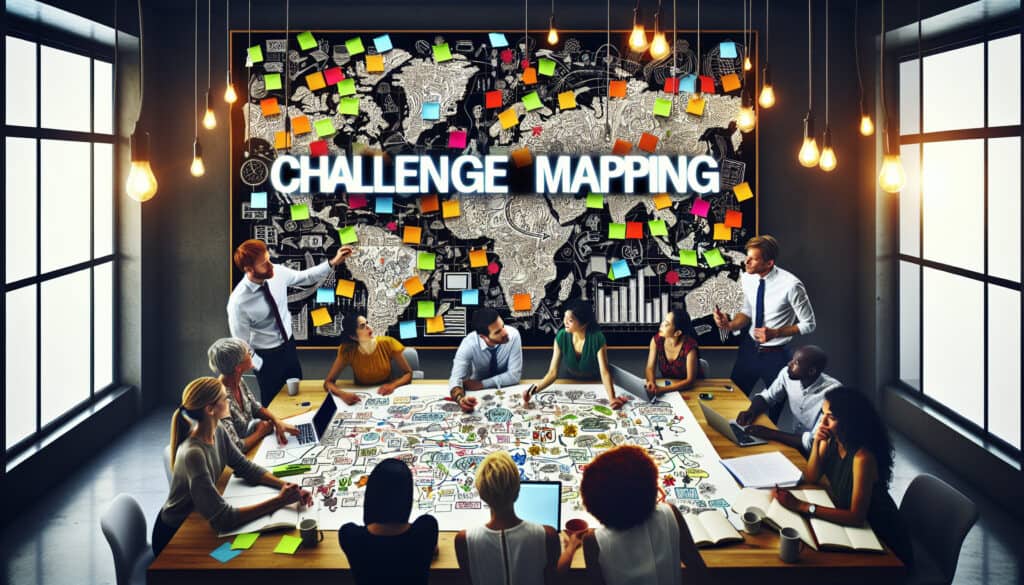A brainstorming Verfahren that focuses on reframing a problem or challenge as an opportunity to generate more innovative solutions.
- Methodologien: Maschinenbau, Ergonomie
Challenge Mapping

Challenge Mapping
- Agile Methodik, Brainstorming, Kontinuierliche Verbesserung, Kreativität, Funktionsübergreifende Zusammenarbeit, Design Denken, Ideenfindung, Innovation, Problemlösungs-Techniken
Zielsetzung:
Wie es verwendet wird:
- Instead of stating a problem, the team formulates a central challenge question (e.g., 'How might we...?'). This question is then broken down into smaller, actionable sub-questions to guide ideation.
Vorteile
- Reframes problems into positive, opportunity-focused questions, encourages a broader range of creative ideas, and helps to structure the brainstorming process.
Nachteile
- Requires skill to formulate effective challenge questions, can be abstract for some participants, and may take longer than traditional brainstorming.
Kategorien:
- Ideenfindung, Problemlösung
Am besten geeignet für:
- Reframing problems as open-ended challenges to stimulate creative and solution-oriented thinking.
Challenge Mapping proves valuable in various sectors such as product design, consumer electronics, and even community development, where the emphasis is on driving innovation through collaboration. During the initial phases of project development, diverse teams consisting of designers, engineers, and stakeholders convene to define a central challenge question like “How might we enhance user experience in our product?” This open-ended approach encourages participants from different backgrounds to contribute unique perspectives, enriching the brainstorming process with multifaceted ideas. Examples include tech companies utilizing Challenge Mapping to reimagine user interfaces by breaking down the broader challenge into specific inquiries about usability, accessibility, and engagement. In the healthcare sector, teams may use this methodology to explore innovative ways to improve patient care by dissecting the challenge into sub-questions concerning technology integration, patient feedback, and workflow efficiency. The collaborative nature of Challenge Mapping invites involvement from various sectors within an organization, promoting cross-functional teamwork. As teams brainstorm based on the refined sub-questions, they generate a wider array of potential solutions that can be prototyped and tested, thus accelerating the innovation process while ensuring solutions are rooted in user-centric design principles.
Die wichtigsten Schritte dieser Methodik
- Define the central challenge question using the format 'How might we...?'.
- Identify key themes or areas related to the central challenge.
- Break down the central challenge into smaller, actionable sub-questions.
- Generate ideas corresponding to each sub-question through brainstorming sessions.
- Encourage diverse perspectives by inviting contributions from various stakeholders.
- Iterate on ideas by combining, refining, or reshaping them as necessary.
- Prioritize ideas based on feasibility, impact, and alignment with the challenge.
- Develop a prototype or outline for the most promising concepts.
Profi-Tipps
- Incorporate diverse stakeholder viewpoints early in the process; this can uncover hidden assumptions and broaden the range of possible solutions.
- Create a visual framework for sub-questions using mind maps or flowcharts; this aids in clarifying relationships between challenges and enhances collaborative ideation.
- Set specific criteria for evaluating sub-questions; this helps prioritize which ideas to pursue further, ensuring resources are allocated effectively.
Verschiedene Methoden lesen und vergleichen, Wir empfehlen die
> Umfassendes Methoden-Repository <
zusammen mit den über 400 anderen Methoden.
Ihre Kommentare zu dieser Methodik oder zusätzliche Informationen sind willkommen auf der Kommentarbereich unten ↓ , sowie alle ingenieursbezogenen Ideen oder Links.
Historischer Kontext
1949
1950
1950
1960
1960
1960
1960
1940
1950
1950
1958
1960
1960
1960
1960
(wenn das Datum nicht bekannt oder nicht relevant ist, z. B. "Strömungsmechanik", wird eine gerundete Schätzung des bemerkenswerten Erscheinens angegeben)















Verwandte Artikel
Fragebögen zu muskuloskelettalen Beschwerden
Multivariate Tests (MVT)
Mehrfache Regressionsanalyse
Motion-Capture-Systeme
MoSCoW-Methode
Moods Median-Test